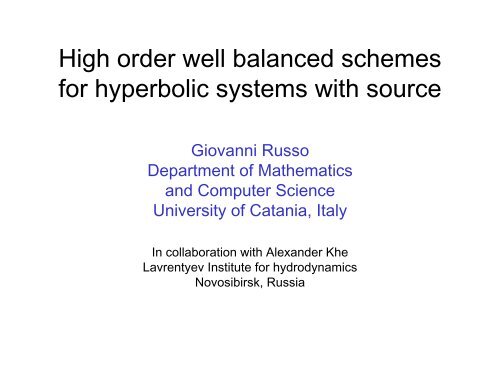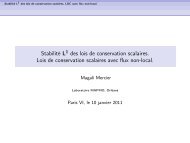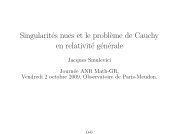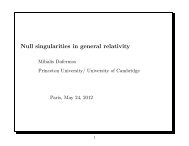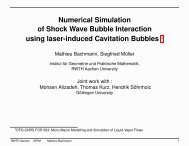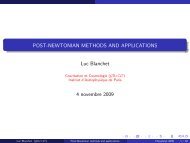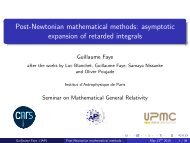High order well balaced schemes for systems of - Philippe LeFloch
High order well balaced schemes for systems of - Philippe LeFloch
High order well balaced schemes for systems of - Philippe LeFloch
Create successful ePaper yourself
Turn your PDF publications into a flip-book with our unique Google optimized e-Paper software.
<strong>High</strong> <strong>order</strong> <strong>well</strong> balanced <strong>schemes</strong><strong>for</strong> hyperbolic <strong>systems</strong> with sourceGiovanni RussoDepartment <strong>of</strong> Mathematicsand Computer ScienceUniversity <strong>of</strong> Catania, ItalyIn collaboration with Alexander KheLavrentyev Institute <strong>for</strong> hydrodynamicsNovosibirsk, Russia
General features <strong>of</strong> the new approachGoal: introduce a methodology to derive• Well balanced property <strong>for</strong> static and moving equilibria• <strong>High</strong> <strong>order</strong> accuracy (depends on WENO)• Applicable to a wide class <strong>of</strong> <strong>systems</strong> with source• Applicable to staggered and unstaggered finite volume <strong>schemes</strong>• At a numerical level requires the solution <strong>of</strong> local equilibria• Conceptually simple
Outline• Well balanced <strong>schemes</strong>• Conservative and equilibrium variables• Staggered finite volume• Non staggered FV <strong>schemes</strong>• Conservative reconstruction <strong>of</strong> equilibrium variables• Numerical tests:– Shallow water equations– Nozzle flow• Well balanced ADER <strong>schemes</strong>• Numerical reconstruction <strong>of</strong> equilibrium states• Work in progress
Well balanced <strong>schemes</strong>Consider a system <strong>of</strong> balance laws:Denote by the stationary solution, satisfying equil. Eqn.A method is <strong>well</strong> balanced if it satisfies a discrete version<strong>of</strong> the equilibrium equation.If a method is not <strong>well</strong> balanced, truncation error <strong>of</strong> solutionsenear equilibrium may be larger than u( x,t)− u ( x)
Some references (not complete!)Bernudez, A., Vazquez, M.E., 1994, Computer Fluids.L. Gosse, LeRoux, 1996, WB scheme <strong>for</strong> scalarGreenberg, LeRoux, 1996, … non conservative productsR. Le Veque, 1998, WB Godunov scheme based on wave propagationG.R., HYP2000, WB central scheme (staggered)Perthame and Simeoni, 2001, WB kinetic schemeS.Jin, 2001, WB FV scheme <strong>for</strong> <strong>systems</strong> with geometric sourceKurganov and Levy, 2002, WB central unstaggeredG.R., 2002, central staggered, preserve non static equilibriaBouchut, 2004, nonlinear stability <strong>of</strong> finite volume, Birkhauser...Noelle, Pankratz, Puppo, Natvig, 2007, <strong>High</strong> <strong>order</strong>, FV <strong>well</strong> balancedNoelle, Shu, Xing, 2007, high <strong>order</strong> WB WENO FV schemeGallardo, Pares, Castro, JCP, 2007, high <strong>order</strong>, wb sw topography & dry areasKhe and G.R., 2008, Hyp. conference, Maryland
A second <strong>order</strong> WB scheme <strong>for</strong> shallow waterPrototype <strong>of</strong> hyperbolic system with source term.Probably the most studied case.Valid when the wavelength >> water depth.Pressure is hydrostatic, and horizontal velocity does notdepend on vertical coordinate.Equations:
When and why does it work?• The method preserves static equilibriabecause if w = 0 then H = h + B is constant.• The method works because the unknownvariables are also equilibrium variables.• It would be nice to use equilibrium variables<strong>for</strong> the evolution, but then one would looseconservation.• Key point: conservative mapping betweenequilibrium and conservative variables.
Conservative and equilibrium variables 1/2In many cases, equilibrium (<strong>for</strong> smooth solutions)some functions <strong>of</strong> the conservative variables are constant.For example, <strong>for</strong> shallow water:At equilibrium q ≡ hw = const, andfrom the second equation the following variable is constant:[Energy density – mathematical entropy]
Conservative and equilibrium variables 2/2Some notation:Let us denote by u the conservative variableand by v the equilibrium variable.We shall assume that there is a 1 to 1 correspondenceBetween u and v:u = U ( v,x)⇔ v = V ( u,x)In the case <strong>of</strong> shallow water, one has⎛ h⎞⎛ q ⎞2 2u = ⎜ ⎟, v = ⎜ ⎟ η(h , q,x)= q /(2h) + g~ ( h + B(x))⎝q⎠ ⎝η⎠Inversion requires solution <strong>of</strong> a cubic equation (which weassume we can do. Must be careful <strong>for</strong> transcritical cases)
Forward Euler in timeFirst <strong>order</strong> schemeHow to do it in such a way that the scheme is conservativeand <strong>well</strong> balanced?Basic idea: use conservative variable <strong>for</strong> the evolution,and equilibrium variables to help the reconstruction
Define equilibriumcell averageFirst <strong>order</strong> scheme - 2Note: This definition has been used by Noelle, Shu and XingThen define the needed quantities as:Staggered cell valuesPointwise valuesStaggered source averages
Well balanced propertyIt is easy to show that, if { un j} are cell averages <strong>of</strong> equilibriumsolution, thenandLet be an equilibrium solution, and let be thecorresponding equilibrium variable. ThenIntegrating the equilibrium equation over the space:Making use <strong>of</strong> this relation in the evolution <strong>for</strong> the cell average:
<strong>High</strong> <strong>order</strong> in space:conservative reconstructionConsider WENO 2-3 in cell jConservative variable u is reconstructed asObtained by imposing correctcell averages in cells j and j + 1 :Set <strong>of</strong> nonlinear equations <strong>for</strong> andSimilarly <strong>for</strong>Remark: conservation property <strong>of</strong> the mapping is neededto ensure that v is actually constant if the set { u j} comesfrom equilibrium solution, not to ensure that the scheme isconservative!
Time integration: central Runge-KuttaEvolution equationCRK approach: numerical solution on the staggered cellStage valuescomputed by theevolution equation in non conservative <strong>for</strong>m on the edge<strong>of</strong> the staggered cell (i.e. at the center <strong>of</strong> the cells)
Computation <strong>of</strong> the stage values 1/2Observe thatwhereA= ∇ufConsider the evolution equationAt equilibriumThis relation in fact can be used to define theequilibrium variable vEvolution equation <strong>for</strong> the stage values:
Computation <strong>of</strong> the stage values 2/2Runge-Kutta coefficientsThe term can be obtained using WENOon the derivatives <strong>of</strong> the reconstructionThe WENO reconstruction is obtained frompointwise reconstruction <strong>of</strong> v obtained from the stage value
Practical considerationsIntegrals on each interval appearing in the non-linearEquations <strong>for</strong> the reconstructions, e.g. <strong>for</strong> WENO 2-3are replaced by Gaussian quadrature <strong>for</strong>mulas.[We used 4 point Gauss-Legendre <strong>for</strong>mulas][which in practice guarantee WB property within round <strong>of</strong>fError in our tests]WB error depends on the tolerance <strong>for</strong> the solution <strong>of</strong> thenonlinear equationsOther reconstruction techniques are possible (see last part)
Unstaggered gridsskipEvolution equationNumerical flux functionBoarder valuesWith (WENO 2-3)Source average
Forward EulerLet us show WB propertyAssume equilibrium initial dataThenThere<strong>for</strong>e, by consistency:Source cell averageAbove relations implyAnd there<strong>for</strong>e
<strong>High</strong> <strong>order</strong> <strong>schemes</strong>Can be obtained by applying RK <strong>schemes</strong> in timeNumerical solutionStage valuesValues at cell edges:[conservative reconstruction]Using same argument as Euler scheme, it can be proved it is WB,i.e. because it is proportional to derivatives <strong>of</strong>
Numerical tests:staggered FV <strong>schemes</strong>Schemes compared• First <strong>order</strong>: piecewise constant,<strong>for</strong>ward Euler• Second <strong>order</strong>: piecewise linear, MM limiter,CRK2 (modified Euler)• Third <strong>order</strong>: compact WENO,CRK3• Fourth <strong>order</strong>:Central WENO (3 parabolas),CRK4
Numerical tests• Models considered:– Saint Venant equations <strong>of</strong> shallow water– Nozzle flow <strong>for</strong> Euler equations• Test per<strong>for</strong>med to check– WB property <strong>for</strong>• Static equilibria• Moving equilibria– Order <strong>of</strong> accuracy– Shock capturing property
Shallow water – static equilibiumN = 200, 3200First <strong>order</strong>Second <strong>order</strong>h ( x , t 1)q ( x , t 1)h ( x , t 1)q x , t )(1
Shallow water – static equilibiumN = 200,3200Fourth <strong>order</strong>Third <strong>order</strong>
Shallow water – moving equilibiumN = 200, 3200First <strong>order</strong>Second <strong>order</strong>h ( x , t 1)q ( x , t 1)h ( x , t 1)q x , t )(1
Shallow water – moving equilibiumN = 200, 3200Third <strong>order</strong>Fourth <strong>order</strong>h ( x , t 1)q ( x , t 1)h ( x , t 1)q x , t )(1
Equilibrium preservationShallow water, Moving equilibrium, 1st <strong>order</strong> schemeL1 errors in h and q, dt/dx = 0.2Cells: 100: 2.7693E-010 1.9099E-010Cells: 200: 5.4388E-010 3.8929E-010Cells: 400: 1.0930E-009 7.8746E-010Shallow water, Moving equilibrium, 4th <strong>order</strong> schemeL1 errors in h and q, dt/dx = 0.2Cells: 100: 2.6651E-013 4.2220E-014Cells: 200: 5.6666E-013 3.8355E-014Cells: 400: 1.4794E-011 6.9670E-012
Accuracy test (smooth solution)Skip non staggered
Non‐staggered <strong>schemes</strong> <strong>for</strong> shallow waterNumerical Flux —HLL Riemann SolverCFL number = 0.91 st <strong>order</strong> scheme2 nd <strong>order</strong> scheme:o Piecewise linear reconstruction with MinMod limitero Modified Euler4 th <strong>order</strong> scheme:o WENO parabolic reconstructiono Runge—Kutta 4Number <strong>of</strong> cells: 100 and 3200
Moving Equilibrium1.2• Initial ConditionsFinal time = 0.3810.80.6hx ( )⎧H( x, q0, ε0) + 0.001, x∈[0.45,0.55]= ⎨⎩ H( x, q0, ε0), otherwise0 00.40.2u = q / h ( x), x∈[0,1]00 0.1 0.2 0.3 0.4 0.5 0.6 0.7 0.8 0.9 1bx ( )( π x )⎧⎪ 0.25 1+ cos 20 ( −0.65) , x∈[0.6,0.7]= ⎨ ⎪ ⎩0.0, otherwise
1 st <strong>order</strong> scheme• Left: h, Right: q = rho u•Solid: 3200 cells, Crosses: 100 cells1.0011.00081.0006Initial3200 cells100 cells0.20050.20040.20030.20020.20011.00041.00020.20.19990.199810.99980 0.1 0.2 0.3 0.4 0.5 0.6 0.7 0.8 0.9 10.19970.1996Initial3200 cells100 cells0.19950 0.1 0.2 0.3 0.4 0.5 0.6 0.7 0.8 0.9 1
4 th <strong>order</strong> scheme• Left: h, Right: q = rho u•Solid: 3200 cells, Crosses: 100 cells1.0011.00081.0006Initial3200 cells100 cells0.20050.20040.20030.20020.20011.00041.00020.20.19990.199810.99980 0.1 0.2 0.3 0.4 0.5 0.6 0.7 0.8 0.9 10.19970.1996Initial3200 cells100 cells0.19950 0.1 0.2 0.3 0.4 0.5 0.6 0.7 0.8 0.9 1
Accuracy Tests• Tests per<strong>for</strong>med:• 100, 200, 400, 800, 1600, 3200 cellsh q0.879 0.9800.934 0.9840.970 0.9950.984 0.997h q1.837 1.8861.913 1.8861.899 1.9551.764 1.797h q3.980 3.9444.060 4.0464.136 4.1234.094 4.087
Nozzle flowEuler equations on a channel <strong>of</strong> variable cross sectionCross section <strong>of</strong> the channelInitial conditionPeriodic B.C.CFL = 0.2Final time T=0.26
Conservative and Equilibrium variablesConservativeEquilibrium~A new equilibrium variable S = S / S 0( x)is used in place <strong>of</strong> S.~The new variable is S =1 at equilibrium.Calculations are per<strong>for</strong>med with staggered grid
Nozzle flow – shock capturing and WBPressureVelocitySecond <strong>order</strong>First <strong>order</strong>
Equilibrium preservationNozzle flow, Moving equilibrium, 1st <strong>order</strong> schemeL1 errors in conservative variables, dt/dx = 0.2Cells: 100: 2.2272E-016 1.9529E-015 6.7946E-016Cells: 200: 9.9143E-016 3.5666E-015 4.7939E-015Cells: 400: 3.4360E-015 1.6227E-014 3.1442E-015Nozzle flow, Moving equilibrium, 2nd <strong>order</strong> schemeL1 errors in conservative variables, dt/dx = 0.2Cells: 100: 3.5016E-016 3.7648E-015 7.9936E-016Cells: 200: 7.6102E-016 4.7445E-015 3.1175E-015Cells: 400: 1.5455E-015 2.7246E-014 1.4070E-014
Nozzle flow: accuracy test
Application to ADER <strong>schemes</strong>The procedure can be used to construct WB ADER <strong>schemes</strong>.ADER is a technique introduced by Toro and developed by Toro,Titarev, Dumbser, etc. (recall talk <strong>of</strong> Castedo Ruiz on monday).In classical ADER <strong>schemes</strong>, the numerical solution <strong>of</strong> asystem <strong>of</strong> the <strong>for</strong>mis obtained as follows: integrating over a cell one obtainsSkip ADER
summary <strong>of</strong> ADER <strong>schemes</strong>• The solution at cell edges may be computed by Taylorexpansion in time at cell edges.• Taylor expansion contains time derivative <strong>of</strong> the solutionevaluated at the initial time.• Differentiating the original equation in space, time derivativescan be computed from space derivatives (Cauchy-Kovalewsky procedure).• The initial value at the cell edge is evaluated by the solution<strong>of</strong> the Riemann problem (or by an approximate Riemannsolver)• The initial value <strong>of</strong> the space derivatives at cell edges isevaluated by the solution <strong>of</strong> a linear Riemann problem.Remark: Taylor expansion can be replaced by Runge-Kuttaprocedure (G.R., Titarev, Toro, 2006)
Using the propertyADER WB <strong>schemes</strong>the evolution equation on cell edges becomes:Now, if are cell averages <strong>of</strong> an equilibrium solutionthen one hasWhich impliesAnd there<strong>for</strong>e
Numerical reconstruction <strong>of</strong>(A.Khe, G.R., in preparation)equilibrium statesThe approach used so far requires the explicit knowledge<strong>of</strong> the mapping between conservative and equilibriumvariables.Such a mapping is not always available or known.It would be desirable to <strong>for</strong>mulate the method withoutrelying on the explicit knowledge <strong>of</strong> the mapping.This can be obtained by a numerical reconstruction <strong>of</strong>equilibrium states
Equilibrium statesDefined by (1)whereLocal equilibrium in cell is defined by (1)and(2)A state which is <strong>for</strong>med by piacewise local equilibrium statesis the natural generalization <strong>of</strong>a piecewise constant state <strong>for</strong><strong>systems</strong> without source( : char. function <strong>of</strong> , solution <strong>of</strong> (1) and (2) )
Numerical local equilibriaSolve Eq.(1) and (2) numerically, e.g. by collocation.Look <strong>for</strong> an approximate solution in a finitedimensional space, say polynomial <strong>of</strong> degreewhich gives p+1 equations <strong>for</strong> p+1 unknownsRemarks• By piacewise local equilibria one can construct WB<strong>schemes</strong> <strong>of</strong> <strong>order</strong> one.• The quality <strong>of</strong> WB property depends on the accuracy <strong>of</strong>the solution <strong>of</strong> local equilibria (at equilibrium there arejumps )
First <strong>order</strong> schemeStaggered schemeIt isbecause =0(a part from )Unstaggered schemewhich at equilibrium gives
<strong>High</strong> <strong>order</strong> <strong>schemes</strong>Are obtained by high <strong>order</strong> reconstructions from local equilibria(rather than from constant states)Second (and third) <strong>order</strong> recons. (equivalent to WENO2-3)In cell define function aswhereare the WENO weightand the local equilibria , are defined in :
They satisfy the collocationequation in p points inand the cell averageconditionsLinear polynomialsare obtained by imposing thatthe reconstruction is conservative:4x4 linear system
RemarkThis property is satisfied by the first <strong>order</strong> polynomialsthat matches cell averages on two adjacent cells inclassical FV <strong>schemes</strong>:
Time advancement (staggered version)Staggered cell average computed from the reconstructionInitial values at cell center computed by from the reconstructionnumerical solution does not change (to )if stage values do not change.Stage values: computed fromRHS = 0 at equilibrium<strong>High</strong>er <strong>order</strong> <strong>schemes</strong>Can be constructed with a similar procedureHere we construct up to a fourth <strong>order</strong> method
Application to scalar equationBottom pr<strong>of</strong>ile: hump centered in 0.6
Second <strong>order</strong> scheme
Fourth <strong>order</strong> scheme
Test with a smooth solutionCheck <strong>for</strong> convergence rate ( error)Second <strong>order</strong> schemeFourth <strong>order</strong> scheme
Application to shallow water
Shallow water system4 th Order SchemeI. Lake at rest1.210.80.60.40.201.0110 0.1 0.2 0.3 0.4 0.5 0.6 0.7 0.8 0.9 1Initial configuration1.0051.004Total height0.0060.004Discharge1.0030.0021.00201.001-0.00210.9990 0.1 0.2 0.3 0.4 0.5 0.6 0.7 0.8 0.9 1-0.004-0.0060 0.1 0.2 0.3 0.4 0.5 0.6 0.7 0.8 0.9 1Solid — 4000 cells, Circles — 100 cellsOne can notice small perturbations over [0.6, 0.7]due to numerical reconstruction
Shallow water system4 th Order SchemeII. Moving Equilibrium1.210.80.60.40.201.0110 0.1 0.2 0.3 0.4 0.5 0.6 0.7 0.8 0.9 1Initial configuration1.0061.0051.0041.0031.0021.00110.999Total height0 0.1 0.2 0.3 0.4 0.5 0.6 0.7 0.8 0.9 10.2050.2040.203 Discharge0.2020.2010.20.1990.1980.1970.1960.1950 0.1 0.2 0.3 0.4 0.5 0.6 0.7 0.8 0.9 1Solid — 4000 cells, Circles — 100 cellsOne can notice small perturbations over [0.6, 0.7]due to numerical reconstruction
Total heightReconstruction: restDischarge1.0051.0041.0034000 cells400 cells200 cells100 cells0.0060.0040.0021.00201.00110.9990 0.1 0.2 0.3 0.4 0.5 0.6 0.7 0.8 0.9 1-0.002-0.004-0.0064000 cells400 cells200 cells100 cells0 0.1 0.2 0.3 0.4 0.5 0.6 0.7 0.8 0.9 11.00040.00041.00020.0002100.99980.9996400 cells200 cells100 cells-0.0002-0.0004400 cells200 cells100 cells0.55 0.6 0.65 0.7 0.750.55 0.6 0.65 0.7 0.75
Reconstruction: movingTotal heightDischarge1.0061.0051.0041.0031.0021.00114000 cells400 cells200 cells100 cells0.9990 0.1 0.2 0.3 0.4 0.5 0.6 0.7 0.8 0.9 10.2050.2040.2030.2020.2010.20.1990.1980.1970.1960.1954000 cells400 cells200 cells100 cells0 0.1 0.2 0.3 0.4 0.5 0.6 0.7 0.8 0.9 11.00041.0002400 cells200 cells100 cells0.20150.2010.2005400 cells200 cells100 cells10.20.99980.19950.99960.55 0.6 0.65 0.7 0.750.1990.19850.55 0.6 0.65 0.7 0.75
Numerical Tests. OrderL1-norm <strong>of</strong> errorOrderCells h q h q64128 1.42e-5 1.63e-5256 5.90e-7 5.86e-7 4.59 4.80512 2.55e-8 2.32e-8 4.53 4.661024 1.19e-9 9.83e-10 4.42 4.562048 6.17e-11 4.80e-11 4.27 4.364096 3.58e-12 2.84e-12 4.11 4.088192 2.20e-13 1.76e-13 4.03 4.01
Conclusion<strong>High</strong> <strong>order</strong> WB can be obtained using:conservative variables <strong>for</strong> the evolutionequilibrium variables used in the reconstructionanalytical knowledge <strong>of</strong> equilibrium variables is notnecessaryWork in progress• Include other effects (dry zones, transcritical flow, etc.)• Apply to other models (stratified athmosphrere, …)• Apply numerical reconstruction to problems with morespace dimensions• Connections with other approaches


